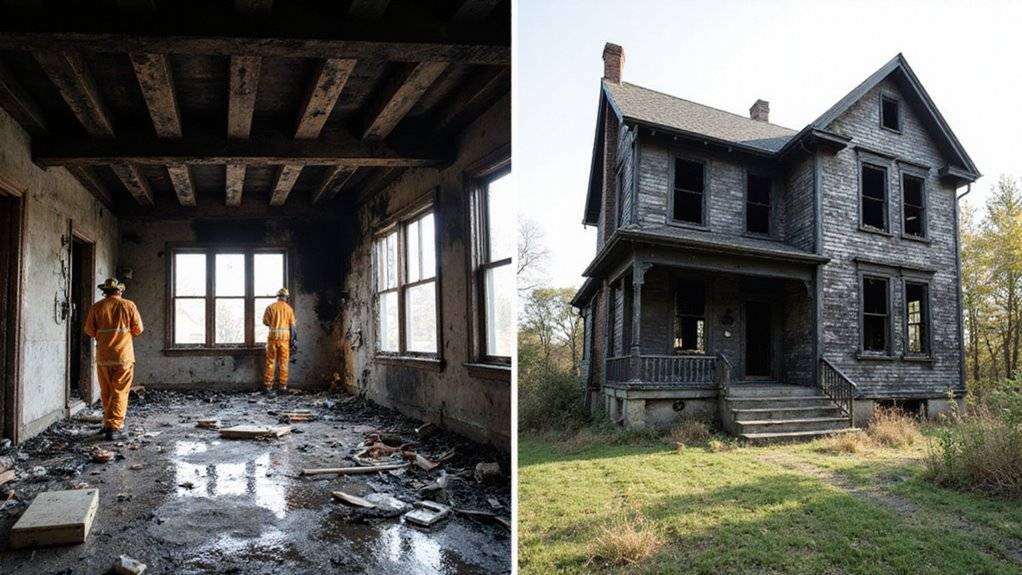Fire damage can silently weaken your home’s structure, even if flames didn’t touch every spot. Standing among ashes and ruin, the weight of deciding what’s next feels heavy. This problem can overwhelm anyone facing such loss.
The choice between restoring your home or selling as-is stirs stress and doubt. Financial costs and emotional tolls clash, making every option seem daunting. Delaying a decision only deepens the struggle. Yet, there’s a way to find clarity amidst the chaos of fire damage.
Restoration or selling as-is depends on your unique needs and goals. This guide will help you weigh both paths wisely. This blog offers insights to solve your dilemma with confidence. Let’s navigate this tough choice together.
Key Takeaways
- Fire damage restoration rebuilds property, increasing value, but takes months and incurs high costs.
- Selling as-is avoids repair expenses and speeds up sale, often within days or weeks.
- Restoration preserves historical value and reduces environmental waste, unlike selling as-is.
- Selling as-is may result in lower sale prices and limits buyer interest due to damage.
- Restoration risks delays and hidden fees, while as-is sales reduce emotional and financial strain.
Understanding the Impact of Fire Damage on Your Property

When assessing fire damage to your property, you must first consider the structural damage and safety concerns that can compromise the building’s integrity. Beyond the visible destruction, you’re also dealing with smoke, soot, and water contamination that can seep into materials, posing health risks and further deterioration. Understanding these impacts helps you make informed decisions about whether to restore or sell as-is. Selling a damaged property as-is home sale can be a viable option if repair costs are prohibitive.
Structural Damage and Safety Concerns
Fire damage can seriously harm your property’s structure, creating urgent safety risks. If flames weaken beams or walls, collapse becomes a real threat. A professional engineer should check if the building is safe to use.
Ignoring this damage might put lives at risk and cause big problems. You must act quickly to avoid further danger. If issues are severe, staying in the property could be unsafe.
Hazard Mitigation is key to securing weak spots and fixing urgent damage. Make sure unstable areas are stabilized fast. This helps lower the chance of accidents or injuries.
Emergency Preparedness means having a plan for evacuation or moving temporarily. If the situation worsens, you need to be ready. Acting fast can help you decide on restoring or selling the property.
Smoke, Soot, and Water Contamination
Fire leaves hidden damage through smoke, soot, and water. These elements create serious issues if not handled quickly.
Smoke and soot settle into every corner of your property. They can trigger allergies and harm your breathing. If ignored, soot releases toxins from fabrics and walls over time.
Water used to stop the fire brings new problems. It can lead to mold growth and weaken structures. If not dried fast, this damage worsens.
Smoke and water create dangerous environmental risks. They harm air quality and threaten safety. You must act fast to protect your property and health.
What Is Fire Damage Restoration?
When you’re facing fire damage, understanding fire damage restoration is crucial to making an informed decision about your property. This process involves a series of steps to repair and rebuild affected areas, and we’ll break down what that entails for you. You’ll also need to consider the costs involved, as they can significantly impact your choice between restoring or selling as-is. Additionally, exploring options like selling to cash buyers can provide a faster alternative if restoration costs are prohibitive.
The Restoration Process Explained
Fire damage restoration helps bring your property back to normal after a disaster. It follows a clear, step-by-step process to fix damages. If you choose this path, knowing the basics is important.
First, experts check the property for structural issues and smoke residue. They also look for water damage from firefighting efforts. If damage is severe, immediate action becomes necessary.
Professionals use modern tools to clean and repair affected areas. They often choose eco-friendly materials to reduce waste. If delays happen, problems like odor can worsen.
Debris removal clears the mess left by the fire. Odor neutralization ensures the smell disappears completely. If done right, surface restoration makes everything look new.
Understanding these steps helps you decide on restoration. If safety and quality matter, this process could work well. Take time to consider your property goals.
Costs Involved in Fire Damage Restoration
Fire damage restoration can be expensive, and costs often exceed initial budgets. You must plan carefully to manage expenses. If hidden fees appear, they can surprise you with extra charges.
Labor costs are high due to the need for skilled workers. Replacing damaged materials also adds to the bill. If delays happen, they might increase your total expenses.
Equipment for cleanup and repair is another major cost. Specialized tools are necessary for proper restoration work. If you don’t budget for this, you may face financial strain.
Understanding these factors helps you prepare for the investment. If you overlook any cost, it could lead to surprises. Stay informed to avoid unexpected financial burdens.
Pros and Cons of Restoring a Fire-Damaged Property

As you consider restoring a fire-damaged property, you’ll find significant benefits, like increasing the property’s value and making it livable again. However, you must also weigh the challenges and risks, such as high costs and potential structural issues that could complicate the process. Let’s examine these factors to help you make an informed decision. Additionally, careful planning and professional documentation are essential to ensure transparency and protect against future complications during the restoration process.
Benefits of Restoring
Restoring a fire-damaged property brings many advantages if you invest time and effort. It saves a building and boosts its worth. This choice helps keep the home’s special charm while adding new features.
Restoration is good for the environment as it reuses old materials. If you rebuild, you create more waste. This process lowers your impact on nature.
The property’s history or personal value stays alive through restoration. If it holds memories, this matters a lot. You honor its past by bringing it back.
A restored home can increase in value over time. If the market is right, you gain a good return. This makes restoration a smart financial move.
Restoration lets you build a space that feels like yours. If done well, it can also bring profit. This balance makes the effort worthwhile.
Challenges and Risks
Restoring a fire-damaged property has benefits, but it also brings serious challenges. Environmental hazards like smoke toxins or asbestos can be dangerous. If mishandled, these risks could harm health or cause legal issues.
Economic changes can also affect your restoration budget. If material costs rise or labor is scarce, expenses may increase. Such surprises might turn your project into a financial strain.
Delays are another concern during restoration. Permitting problems or contractor shortages could slow down progress. If not planned well, these issues might disrupt your timeline.
Careful management is essential to handle these risks. If you prepare properly, challenges may feel less overwhelming. Always weigh these factors before starting the project.
What Does Selling As-Is Mean After a Fire?
When you’re considering selling your fire-damaged property as-is, you’re opting to list it in its current condition without making any repairs or improvements. This process means you’ll transfer ownership with all existing damage, often at a lower price, and it’s crucial to understand the legal and financial implications of this choice. You should also know that buyers of as-is properties are typically investors or cash buyers looking for discounted deals to renovate or rebuild. Additionally, selling as-is can be a hassle-free process for homeowners needing a quick sale after a fire.
Definition and Process of As-Is Selling
Selling a property “as-is” after a fire means offering it in its current, damaged state. You won’t make any repairs or upgrades before the sale. This tells buyers they must handle all restoration work themselves.
This method can save you both time and money on repairs. However, it often leads to a lower sale price. If buyers see extensive damage, they might offer even less.
First, you must disclose the fire damage to potential buyers legally. Then, set a fair price based on the property’s condition and market. If you choose auctions or online platforms, you could reach more buyers quickly.
Who Buys Fire-Damaged Properties As-Is?
Some buyers are interested in fire-damaged properties sold in their current state. These investors often see potential in such homes. If you’re selling, knowing their goals can help you attract offers.
Speculator Groups often buy as-is properties to fix and resell. They understand risks and aim for quick profits. If repairs are minimal, they might offer a fair price.
Foreign Buyers also purchase fire-damaged homes at low costs. They focus on future value or rebuilding opportunities. If the location is good, they may show interest.
Sellers should expect offers with big discounts due to damages. These buyers account for high repair expenses. If you price wisely, serious offers could come faster.
Pros and Cons of Selling a Fire-Damaged Property As-Is

As you consider selling your fire-damaged property as-is, it’s critical to weigh the advantages, like avoiding costly repairs and achieving a faster sale. On the flip side, you’ll need to assess the drawbacks, such as potentially receiving lower offers due to the property’s condition. Understanding these limitations can help you make a strategic decision that aligns with your financial and personal goals. Additionally, companies like ours can provide fair cash offers for homes in any condition, including those with significant fire damage.
Advantages of Selling As-Is
Selling a fire-damaged property as-is can be a smart choice. It helps you avoid costly repairs and saves time. If you choose this path, you can move on quickly.
This option offers a fast sale process. You won’t need to wait for lengthy restoration work. If delays worry you, this could be ideal.
It also cuts down on expenses. You don’t have to spend money fixing the damage. If budgets are tight, this saves stress.
Another benefit is reduced emotional strain. Rebuilding can be tough and draining. If you’re overwhelmed, selling as-is might help.
Finally, it may attract unique buyers. International investors often look for cheap fixer-uppers. If marketed well, your property could sell fast.
Drawbacks and Limitations
Selling a fire-damaged property as-is has clear downsides. You might face environmental risks like toxins or debris. If ignored, these could lead to penalties or costly cleanups.
Properties with fire damage may hold harmful substances. You must disclose these issues to avoid legal problems. If undisclosed, your reputation could suffer greatly.
Selling as-is can limit your buyer pool significantly. Many avoid fire-damaged homes due to safety fears. If sold cheaply, neighbors might worry about property values.
Your decision could affect local perceptions negatively. Neighbors may fear safety risks or declining home worth. If tensions rise, your social standing might drop.
Comparing Financial Outcomes: Restoration vs As-Is Sale
When weighing your options after a fire, you’ll need to assess the potential returns from restoration against the net gains of an as-is sale. Consider how much you’d recover by investing in repairs—restoration can boost property value, but it comes with hefty upfront costs and time. On the flip side, selling as-is might yield quicker cash, though often at a lower price due to the property’s condition. For a faster solution, companies like Freedom Path Investors can provide fair cash offers within 24 hours, avoiding the burden of costly repairs.
Potential Returns from Restoration
Restoration of a fire-damaged property can bring significant financial gains if done right. Choosing to restore often boosts the property’s market value beyond repair costs. It becomes a smart choice when you aim for profit.
Restoring offers more than just money benefits if you consider other factors. It helps the environment by reusing materials and cutting waste. This approach also supports sustainability for a better future.
Preserving historical features during restoration can attract high-paying buyers. Such efforts maintain cultural value and make the property unique. If you value heritage, this adds extra appeal.
Lastly, a restored property often grows in worth over time. This ensures better financial security for the owner. If planned well, restoration proves to be a wise strategy.
Net Gains from As-Is Sale
Selling a fire-damaged property as-is often brings quicker financial gains than restoring it. You avoid repair costs and save valuable time. If you restore, expenses can add up fast.
As-is sales help you skip holding costs like taxes and insurance. These costs grow during a lengthy restoration process. You also reduce maintenance burdens with this choice.
Opportunity costs matter when funds are stuck in a damaged home. If invested elsewhere, that money could earn better returns. Consider this before deciding on repairs.
Market trends affect the sale price of fire-damaged properties. If demand is low, your net gains might shrink. Research buyer interest to predict outcomes.
Weigh all these factors to make a smart financial choice. If gains from as-is seem higher, it might be best. Always analyze your specific situation.
Timeline Considerations: Which Option Is Faster?

When you’re weighing the timeline for fire damage restoration against selling your property as-is, speed becomes a critical factor. Restoration often demands weeks or months of repairs, depending on the extent of the damage, leaving you waiting to move forward. Selling as-is, however, can wrap up much faster, often within days or weeks, if you find the right buyer. For instance, some buyers in St. Louis County offer fast cash closings to expedite the process.
Time Required for Restoration
Restoration after fire damage takes a lot of time. You must consider this when choosing between restoring or selling as-is. If urgent, restoration might not suit your needs.
The process can last for months based on damage severity. It also depends on contractor availability and permit delays. If issues arise, expect even longer waits.
Key steps affect the timeline significantly. First, assessing damage and planning repairs takes weeks. Then, actual repairs may need 3-6 months for moderate damage.
Unexpected problems can slow things down further. Structural issues might add extra time to the project. If unprepared, this wait could be frustrating.
Even with better strategies, restoration remains a long commitment. Innovations might help, but delays are still common. Make sure you can handle the time involved.
Speed of Selling As-Is
Selling a fire-damaged property as-is means a faster process. You avoid long waits for repairs or permits. This choice helps if time matters most to you.
Platforms like Rapid Auctions can connect you with buyers quickly. Deals might close in days or even weeks. If you need speed, this option works well.
Express Listings also target investors looking for fixer-uppers. They help showcase your property for a swift sale. You could get cash sooner by choosing this.
While the sale price may be lower, speed is the benefit. If delays are a concern, this method saves time. It suits those in urgent situations.
Emotional and Psychological Factors
As you navigate the aftermath of a fire, consider how coping with trauma and loss impacts your decision to restore or sell your property as-is. You might find that the emotional weight of rebuilding fuels your motivation to restore, seeking to reclaim what you’ve lost. Alternatively, letting go by selling could offer a quicker path to closure, freeing you from painful memories tied to the damaged space. Additionally, if your property contains hazardous materials, understanding asbestos disclosure laws can influence your decision to sell as-is or undertake restoration.
Coping with Trauma and Loss
Heartache after a house fire can be heavy, as losing belongings and safety hurts deeply. Addressing these feelings is vital for healing. If you seek help, recovery becomes easier.
Consider grief counseling to process your emotions with expert support. It can help you rebuild your inner strength. If you feel stuck, a counselor might guide you forward.
Connecting with loved ones also brings comfort during tough times. Share your thoughts with trusted family or friends. Their support can make you feel less alone.
Practice self-care to calm your mind and find balance. Try simple activities like writing or deep breathing. If stress grows, these can help you relax.
You are not on your own in this journey. Taking small steps can ease the pain of loss. If you stay proactive, healing will come with time.
Motivation to Rebuild vs Letting Go
Deciding to rebuild after a fire or to let go is a personal choice. It depends on your emotional connection to the property. If your home ties to cultural heritage, you may want to restore it.
Rebuilding can show strength and honor past memories. It means committing to a fresh start while respecting history. If the task feels heavy, consider if it’s worth the effort.
Letting go might bring peace by escaping painful memories. You could find new beginnings in a different place. If rebuilding hurts too much, starting over may heal you.
Trust your feelings to guide this tough decision. Your instincts will help you find renewal and healing. Choose the path that feels right for you.
Insurance Coverage and Its Role

When handling the aftermath of fire damage, you’ll need to assess how insurance coverage can shape your next steps. Consider whether using your insurance payout for restoration maximizes the property’s value, or if cashing out with the insurance settlement and selling as-is offers a quicker, less stressful resolution. Both options carry distinct financial and logistical implications that you must weigh carefully. Additionally, if you choose to sell, be aware that profits from the sale may be subject to capital gains tax depending on your residency and profit amount.
Using Insurance for Restoration
After a fire damages your property, insurance is key to starting the restoration process. You must check your policy to see what repairs or rebuilding it covers. If issues arise, disputes with your provider might complicate things.
Understanding your coverage helps avoid unexpected costs during restoration. Review limits and exclusions in your policy carefully. If coverage is lacking, consider extra insurance options for support.
Keep clear records to support your claim effectively. Document all damages and expenses with photos or receipts. This can help if you face claim disputes.
Hiring experts can be useful if problems occur. Public adjusters or lawyers may ensure you get fair compensation. Plan well to make the most of your insurance benefits.
Cashing Out with Insurance and Selling As-Is
Dealing with fire damage, you can cash out through insurance and avoid repair hassles. This approach helps recover losses if your policy covers the damage. It offsets the reduced property value without needing renovations.
Selling as-is means transferring the property in its current condition. You save time and money if you skip repairs. Check your insurance payout against market value to ensure a good deal.
This strategy works well if you prioritize speed over rebuilding. It provides quick funds through insurance benefits. You can move forward easily without restoration stress.
Local Market Conditions and Real Estate Trends
As you weigh the decision between restoring a fire-damaged property or selling it as-is, consider the demand for restored homes in your local market. You’ll need to assess if buyers are eager for move-in-ready properties, which could justify the investment in repairs. Also, check the investor appetite for as-is properties, as some markets have strong interest from flippers or developers looking for fixer-uppers at a lower cost. In North County, MO, local buyers often provide fair cash offers for properties in any condition, making selling as-is a viable option.
Demand for Restored Homes
Restored homes are popular among buyers who want move-in-ready properties. Many people check local market trends to understand this demand. If you’re considering a restoration, knowing buyer preferences can help.
Buyers often look for homes with sustainable materials and energy-efficient features. These upgrades can make your home more attractive. If you add unique elements, your property might stand out.
Key factors affect the demand for restored homes. Market saturation means too many restored homes can lower interest. If your area has many, unique designs could help.
Pricing trends also matter when restoring a home. Check if restored properties sell for more in your locality. If they do, restoration might be a smart choice.
Demographic changes influence demand as well. Younger buyers often prefer modern, low-maintenance homes. If they dominate your market, focus on such features.
With this information, you can plan your restoration wisely. Position your home to meet current buyer needs. If done right, demand could increase.
Investor Appetite for As-Is Properties
Investors are drawn to as-is properties due to today’s market dynamics. Rising renovation costs push them toward cheaper entry points. If budgets are tight, these homes offer high return potential.
Fire-damaged properties attract attention in growing areas. Investors can flip or rent them after quick fixes. If local demand is strong, profits could be significant.
Funding also supports this trend significantly. Many use private lenders or hard money loans for fast closings. If conditions are ignored, deals happen quicker.
Legal and Disclosure Requirements
As you consider selling a fire-damaged property, you must understand the legalities that govern such transactions. You’re required to adhere to specific regulations that ensure transparency, particularly around full disclosure of the property’s condition to potential buyers. Know exactly what information you must share to avoid legal pitfalls and maintain trust in the process.
Legalities of Selling a Fire-Damaged Property
Selling a fire-damaged property involves understanding legal rules to avoid issues. You must follow specific laws to stay protected. If ignored, these rules could lead to future problems.
Key legal points need your attention during the sale. Tax issues might arise, so check for relief options. If damage is severe, confirm any tax benefits or penalties.
Zoning laws are also important to review. They might limit rebuilding or property use after a fire. If non-compliant, you could face restrictions or fines.
Permits and inspections ensure the property is safe for transfer. You should obtain them to confirm its condition. If skipped, legal troubles might follow.
Full Disclosure: What Must Be Shared with Buyers?
Selling a fire-damaged property means you must tell buyers about all damages. Legally, you need to share details on fire damage, structural problems, and hazards. If you hide issues, you could face lawsuits or canceled deals.
Honesty is key when educating buyers about the property. Provide them with repair histories, detailed reports, and inspection findings. This helps buyers decide wisely and builds trust with them.
Transparency offers great benefits for sellers like you. If you are upfront, you avoid legal troubles and gain credibility. It also ensures a smoother sale without disputes.
Being clear protects both you and the buyer. If issues are hidden, disputes may arise later. Full disclosure makes sure everyone knows the property’s true condition.
Working with Professionals: Restoration Experts vs Real Estate Agents
When dealing with fire-damaged property, you’ll need to decide whether to work with restoration experts or real estate agents, and finding reputable fire restoration companies is critical if you choose repairs. Make sure you research firms with proven expertise in handling fire damage to ensure quality work and avoid costly mistakes. If selling as-is feels right, selecting the right real estate professional who understands distressed properties can help you navigate offers and maximize value.
Finding Reputable Fire Restoration Companies
Finding reputable fire restoration companies is crucial for restoring your fire-damaged property. You need a skilled and reliable team. If you search carefully, you can ensure quality results.
Start with checking the company’s background for credentials and experience. Client reviews can show their past work and reliability. If reviews are positive, it’s a good sign.
Follow these key steps to guide your decision. First, verify their certifications for fire restoration standards. If they’re uncertified, avoid them.
Next, assess their response time to prevent more damage. Quick service is essential after a fire. If they delay, look elsewhere.
Finally, confirm their insurance coverage for your protection. Insurance prevents liability issues during restoration. If uninsured, choose another company.
With these steps, you can select a trusted expert. They will rebuild your property safely and effectively. If unsure, keep searching.
Choosing the Right Real Estate Professional
Selling a fire-damaged property as-is can be tricky. Partner with a real estate expert who knows distressed properties well. If you choose wisely, they’ll guide you through the process smoothly.
Finding the right agent starts with asking key questions. Check their experience with as-is sales and marketing plans. If they’ve handled similar cases, you’re on the right track.
Consider getting broker referrals from trusted sources. Industry contacts or local networks can suggest reliable professionals. If they have a strong track record, you’ll feel more confident.
With the right expert, pricing and disclosures become clearer. They’ll help manage buyer expectations effectively. If issues arise, their skills will ensure a better outcome.
Tips for Making the Right Decision
As you weigh the choice between fire damage restoration and selling as-is, start by assessing your personal priorities and long-term goals to ensure the decision aligns with your future plans. Next, analyze the costs, time, and stress levels involved in each option, as these factors can heavily impact your financial and emotional well-being. By carefully considering these elements, you’ll be better equipped to make a sound and practical choice.
Personal Priorities and Long-Term Goals
Deciding between fire damage restoration and selling your property as-is depends on your personal needs and future plans. This choice affects your life ahead, whether it’s about growth or planning for retirement. Think carefully to match your decision with what matters most to you.
Consider your emotional state before choosing a path. Are you ready to rebuild, or do you want a new beginning? If rebuilding feels draining, selling might be the better option.
Look at how this decision fits your future dreams. Does fixing the property help your goals, or does selling open new doors? Your choice should support the vision you hold for yourself.
Think about the legacy you want to create. Will this decision build a strong base for you or your family? If it aligns with your values, you’re on the right track.
Make a wise choice to shape your future with purpose. Your decision today can guide you toward lasting stability. If unsure, take time to reflect on these key points.
Evaluating Costs, Time, and Stress Levels
Deciding between fire damage restoration and selling as-is requires weighing costs, time, and stress. These factors affect your money and emotions directly. If you choose restoration, expect high costs and long delays.
Selling as-is could save money but might bring lower offers. If offers are low, your financial gain may shrink. Consider if waiting for restoration fits your life plans.
Time also impacts your energy and well-being. If repairs drain you, stress can build up fast. Selling as-is may lower stress and help you move on.
Analyze your budget and mental strength before choosing. If you’re stretched thin, avoid overcommitting to repairs. Pick a path that matches your current capacity.
Real-Life Case Studies and Scenarios
As you weigh the options between fire damage restoration and selling as-is, let’s examine real-world examples to guide your decision. Consider a homeowner’s successful restoration journey, where thorough repairs transformed a charred property into a valuable asset. On the other hand, analyze a profitable as-is sale to an investor, where a quick transaction outweighed the hassle of rebuilding.
A Successful Restoration Journey
Explore the amazing process of fire damage restoration through real-life examples. These stories show how expert help can transform ruined homes. If you follow the right steps, recovery becomes possible and efficient.
Key lessons from these successful projects can guide you. Precision planning with Digital Tools helps organize every task clearly. If mistakes happen, these tools can save time.
Sustainability matters in rebuilding damaged spaces. Using Eco Restoration methods reduces harm to the environment during recovery. If you care for nature, this approach works best.
Collaboration with experts speeds up the process. Skilled teams ensure structures are safe and strong again. If challenges arise, their knowledge makes a difference.
Profitable As-Is Sale to an Investor
Selling a fire-damaged property as-is to an investor can be a smart choice. This option offers a fast and profitable solution if done right. Investors often look for such properties to buy at competitive prices.
You can connect with them through Investor Networks for quick deals. Use online platforms or real estate forums to highlight your property’s value. If marketed well, you might sell fast like a Texas homeowner did in two weeks.
Study local market trends to set a fair price for your home. A realistic price will attract serious buyers without delay. If priced correctly, your sale could be smooth and hassle-free.
Build a strong strategy to reach the right investors easily. Share clear details about your property on various channels. If you plan well, the process will be simple and effective.
Conclusion
In conclusion, choosing between fire damage restoration and selling as-is depends on your budget and goals. If you restore, you might recover significant home value. If you sell, you can avoid repair stress.
Should you consider selling as-is, know that we buy houses for cash. This option offers a quick, hassle-free process. If repairs feel overwhelming, we’re here to help.
Contact us at Freedom Path Investors for a fair, no-obligation offer. We’re ready to assist with your decision. Let us guide you through this process.








